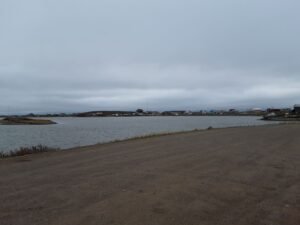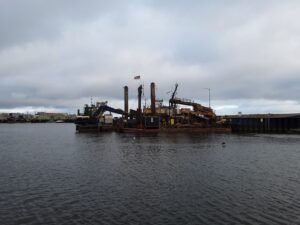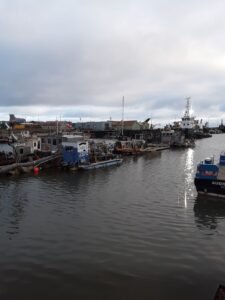
It was as if the world had run out of interesting, that week or two after we got out of the ice at Pasley Bay, and tied Polar Sun up inside the harbor of Gjoa Haven, a little sandy inlet in the greater sandbar that is King William Island. We now had to do some serious reassessment: those nine days trapped in ice in Pasley Bay had really set us back, and to get to the northernmost point in Alaska before the season ended was looking unlikely.
As soon as we were out of Pasley, Mark had worked out the schedule of distances and times needed to get us to Kodiak, Alaska, where we had wanted to leave the boat for the winter. But it wasn’t realistic: it would have required pushing nonstop, without any allowance for weather, and it assumed that fuel and groceries could be secured immediately upon arrival anywhere, with an immediate shove-off after. Even if all those contingencies could come miraculously together this late in the navigable season, it still got us there later than anyone had bargained for. It was time to manage expectations. But nothing is harder than planning without any information, and we had very little of that.

Given that Renan and Rudy had to return home to work, and staring down 1500 miles of late-season sailing with only two people aboard, we decided the most prudent thing was to leave the boat at Cambridge Bay and return next season to finish the passage with more leisure and safety. It would have been the right plan, too, but the crane that had formerly hauled occasional cruising boats out was no longer there. The locals painted a very bleak picture of what Polar Sun would suffer from vandalism even if she survived the dubious prospect of being dragged out on a slipway in a cradle, which Mark would have to have very expensively built. It was like they enjoyed throwing cold water on a poor soul who was already feeling much like the proverbial toad beneath the harrow.

We had already unbent and flaked the sails, and moused out all the halyards by the time it became evident that it wouldn’t be safe to leave Polar Sun there. Unwilling to go, but unable to stay, we reluctantly re-rigged the boat. There was nothing for it: for good or ill, we had to press on and hope for a better scene at Tuktoyaktuk, or at least one no worse. Frankly, it seemed that nothing could be worse than Cambridge Bay for winter storage.

Taking leave of Rudy and his several dozen huge duffels of camera equipment, Mark and I cast off for the six-hundred-mile leg to Tuk. The settled weather we had enjoyed from Gjoa to Cambridge lasted another day or so, and we actually flew the big yellow spinnaker in Coronation Gulf for a few glorious hours. But things changed in the Dolphin and Union Strait, and we put into a cove in Sutton Island to let some weather pass by ahead.
It was a nice night’s rest, at least, but the weather still caught us next night as we battled to get into Amundsen Gulf. It was inevitable: the season was far enough along that the dreaded nor’westers were getting started, and the end of one blocked our exit from the strait, and had us hove-to most of the night with a double-reefed main and stay’sl.
Though the wind mellowed and backed eventually, so we could sail mostly toward Cape Bathurst, we were too tired to properly appreciate it, and too numb to be glad when it died altogether and we could motor directly for our waypoint.


Tuktoyaktuk is on the far side of Cape Bathurst—well really, it’s on the far side of everywhere, and further from anywhere than any other place I’ve been—on a shallow continental shelf. The Mackenzie River empties into the Beaufort Sea there, and shoal-draft barges bring cargoes down from inland to supply the settlements we had just come from with seasonal “sealifts.” From reading about all this activity in the coast pilot, we had assumed Tuk would be a large and bustling port, visible from miles away out to sea. Instead, as we whooshed closer with a strong quartering breeze, we began to wonder if there was anything there at all. All day long we had been less than two miles off the coast, and had seen nothing of it, and even as we came near enough to expect radio towers or some sign of anything, all there was on the horizon were some conical “pingos,” those volcano-like anomalies of the permafrost that abound in these parts.

The buoyed channel and the harbor, normally pretty shallow, had even less water than usual because of the strong easterly breeze that had been blowing all day, and Polar Sun ran aground as we approached the scaffy, half-wrecked public wharf. But there was new life waiting there, in the form of David Thoresen and Ben Spiess, who had arranged last-minute to fly out and join us for the final leg to Alaska.
Without them it would have been terribly difficult, exhausting and dangerous: the north coast of Alaska is long and barren, with precious little shelter for any boats, and less for one carrying a six-foot draft. Luckily we didn’t need shelter until we had sailed dead downwind with a poled-out jib for nearly a week, around Point Barrow, and past Cape Lisburne to Point Hope. Here we stopped and anchored to the north of the point behind the biggest hummock of permafrost we could find. Even though we were tired, and colder than at any other time during the trip, we would gladly have pressed on, but a Pacific typhoon had somehow got lost and wound up in the Bering Sea, and things were going to get spicy down there.

They got spicy enough for us, with gale-force gusts for a day or so, but everywhere south of us got it far worse, and Nome, when we arrived several days later, looked even seedier than its usual gold-rush-frontier town appearance. Our anchorage proved good, though, and when what was left of the eye had come through the Bering Strait and was abeam of us—a tropical depression in the Arctic Ocean, mind you—we made a break across Kotzebue Sound for the Bering Strait.

It was hard sailing, deep reefed and pointing as high as Polar Sun would pinch, with waves slamming and water flinging, and some last-minute doubt that we would weather Cape Prince of Wales without being forced to tack not only away from our goal, but into a foul current that would lose us hours of hard-won ground.
It was just at the moment of despair that the wind shifted, backing enough that we eased the sheets and sailed, surfing at eight and nine knots, through the Bering Strait in pitch-black darkness, less than a half-mile from land to avoid the foul current further offshore, and into the Bering Sea.


Nome, Alaska, is a scruffy hardscrabble town, disconnected from roads and undecorated by vegetation. It only exists because of the gold that, washing down the river, is sought after by scores of prospectors in dredging barges that look like sci-fi movie props, only dirtier. The harbor is filled with these crazy boats, most of them apparently welded together out of other people’s scrap metal and broken dreams; some barely afloat, some abandoned to rot, but all in keeping with the atmosphere of the town. Enough people have struck it rich in Nome, though, that the hopeful still flock to the growing town to try their luck. We hit paydirt ourselves, not in the form of gold, but in finding a boatyard with a trailer that could haul out Polar Sun, and end at last the weary voyage: after nearly six thousand miles sailed and 112 days away from home, it was time to wrap it up. The wind was rising in advance of the next gale that would pound the coast as we took the sails down and flaked them, but we didn’t care. The boat was safe, the voyage done, and home was just a couple airplane rides away.